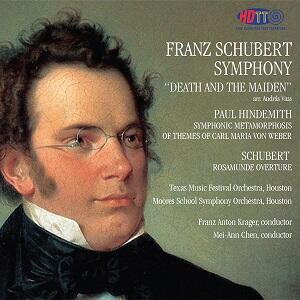
Franz Schubert (1797-1828)
Symphony “Death and the Maiden” (after D.810, orch. András Vass)
Paul Hindemith (1895-1963)
Symphonic Metamorphosis of Themes by Carl Maria von Weber
Franz Schubert (1797-1828)
Rosamunde Overture D.644
Texas Music Festival Orchestra/Franz Anton Krager (symphony), Mei-Ann Chen (Hindemith)
Moores School Symphony Orchestra/Franz Anton Krager (overture)
rec. live, 20 November 2021 (overture), 11 June 2022 (symphony), 25 June 2022 (Hindemith), Moores Opera House, University of Houston, USA
High Definition Tape Transfers 14076 [77]
This very-well-filled programme presents two rarities: the orchestral arrangement of Schubert’s most celebrated string quartet in its “first international recording” and Hindemith’s adaptation of themes by Weber, plus a filler – the more familiar Rosamunde overture. I must start by saying that I thoroughly enjoyed encountering it, despite the occasional orchestral slip and accident.
The sound is superlative being offered in stereo and “5.0 Channel Immersive Surround”, the mix & CD downsampling/mastering by John Gladney Proffitt and the multichannel Blu-ray mastering by Bob Witrak. The occasional cough notwithstanding, very little indicates that it is a live performance – recorded in one take with no editing – apart from the fact that the sound has a wider, concert-hall feeling rather than the narrower, more spotlit acoustic of a studio and there is vociferous and well-deserved applause at the end of each piece. The second pleasant surprise is how familiar and apt the Schubert quartet sounds orchestrated and large-scale; it is very much a close cousin to the mature symphonies. Occasionally, yes, there is an air of grandeur and portentousness about it which is slightly disconcerting when one has become so accustomed to the far leaner textures of a string ensemble, and the passing around of themes from one bank of instruments to another sounds a little formulaic, but for the most part the transition is painless and affords much pleasure. The recapitulation becomes almost Beethovenian in its scale and drama. Despite some rhythmic slips in ensemble, I find myself caught up and swept along by the verve of the playing and conducting here and there is also much to savour: frequently lovely solo work by the virtuosic first violin and flute in the second movement and the variations become more – well, varied owing to the extra range of colours and textures afforded by the inventive orchestration. The aggressively assertive and rather laboured opening to the Scherzo is a weak point, I think, but there is a lilt to the Trio and if one can take its weightiness, the reappearance of the Scherzo is impressive, if a bit crude. The finale is fleeter and conductor Franz Anton Krager’s control of dynamics is skilful and telling. You will never have heard Schubert sound so imposing as in the reprise of the second, “chorale” theme at 6:12; it is positively Wagnerian! There is the occasional, fleeting intonation issue in the playing but for the most part the standard maintained is high. I am amused by the fact that as testimony to the acuteness of the sound engineering, very audible is a positive hailstorm of rattling scores as pages are turned at 9:15, one of the most frenetic junctures in the finale – but that just adds immediacy to a thrilling listening experience.
For those a little chary of Hindemith, let me assure you that his Metamorphosis here is very approachable. Originally conceived as ballet music using themes taken from Weber’s incidental music for the 18C playwright Carlo Gozzi’s Turandot (yes – the same one), abandoned as such and reconceived by Hindemith as a symphonic work, then revived as dance for the New York Ballet by George Balanchine in the 50s, it is predominately lively and rambunctious; the opening Allegro is rather like very superior circus music , loud, jolly and bumptious and often reminiscent of the 20C Russian school at play, with many echoes of Shostakovich, Prokofiev and even Stravinsky in their lighter moods. The alternately sparkling, galumphing and faintly grotesque Scherzo sounds like a dance for trolls, replete with percussive effects. The Andantino is more soothing, bucolic and reflective and graced by some nice phrases from the woodwind section, who carry the melodic burden. With the Marsch we are back in showtime territory and the brass have work to do – and do it well, sustaining repeated fanfare blasts. I didn’t know Hindemith could be such fun – my bad, if you will excuse the yoofspeak.
The opening of the Rosamunde overture is decidedly ragged and ill-tuned, something of a blot given the competence of the rest of the programme; it is also rather elephantine and short of Viennese charm. Perhaps I am in any case biased as I have never been able to appreciate Schubert’s incidental music, finding it banal; it is certainly not the highlight here but when it gets into its stride it is pleasant enough.
The excellent, informative notes by producer John Proffitt provide comprehensive information about the works, composers and artists involved accompanied by lovely colour photographs and illustrations.
Ralph Moore
Previous review: Nick Barnard (March 2023)
Availability: High Definition Tape Transfers

















